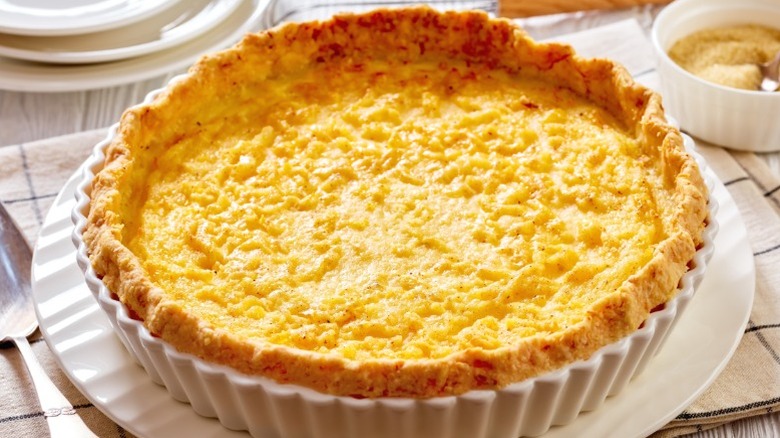How Chess Pie Got Its Strange Name
If you've never had chess pie, a popular Southern dessert, it's sort of like the pound cake of pies. There are no fancy fruits or nuts in the filling of this dessert: just sugar, butter, flour, and eggs, with perhaps a splash of milk or buttermilk (which you can make at home) if you're feeling saucy. If it sounds simple, it is — but simple doesn't necessarily mean bad, or even boring. Just as a slice of pound cake (named for being made from a pound of each ingredient) hits different with a cup of coffee in the morning, chess pie can also brighten your day. Once that happens, all that's needed to make your day complete is to figure out just why the heck it's called chess pie in the first place. There are a few different theories, not all of which have to do with the actual game of chess.
One theory involves something called an "eggcorn," or a word that comes about due to somebody mishearing or mispronouncing another word. The idea is that somebody, when asked what it was they were bringing to a social gathering, might say "it's just pie" — which, in a Southern accent, would sound more like "it's chess pie." Another holds that the name came from the dessert's supposed place of origin, Chester, England; a third suggests that it might have been enjoyed by Southern men in their parlors while playing chess after dinner.
Chess pie's name might have come from its ingredients or preparation
Two of the more convincing theories involve similar distortions of other words to the "just pie" story. One possibility is that "chess pie" was once "cheesecake pie", which eventually became "chess-cake pie". In fact, Martha Washington, who also made something called Great Cake, once had a recipe for "chess cake," which is almost identical to what we now know as chess pie. (Not that there was really cheese in chess pie, of course, but it was sweet and creamy enough that the comparison didn't come from nowhere.) There's also the possibility that the "chess" came from "chestnut," as chestnut meal was once commonly used as a binding agent for the pie.
Or perhaps the name didn't come from an ingredient, but from a method of storage. Because chess pie is a rather sturdy concoction that holds up at room temperature, it was often stored in something called a "pie chest" — which may have resulted in the name "chest pie," which then became "chess pie." As is so often the case when it comes to the origins of our favorite dishes, there probably isn't one single answer. But a chess pie by any other name will taste just as sweet. (Or is that "chess as sweet"?)

